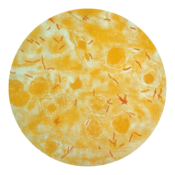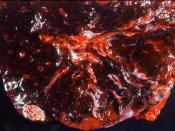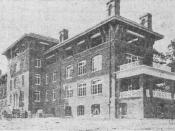Tuberculosis is a disease caused by mycobacterium tuberculosis. After being spread, the tuberculosis can be either active or inactive. In the 19th century, tuberculosis was widespread in industrialized countries. The disease has decreased steadily since the 1950's, when the first tuberculosis drugs were introduced. There are now strains of the tuberculosis disease that are drug resistant.
Tuberculosis is spread by respiratory droplets from somebody with active tuberculosis. The mycobacterium tuberculosis is a rod shaped bacterium with a waxy capsule. When tuberculosis enters the body, it does not attract polymorphonuclear leukocytes. Tuberculosis is most common in the lungs. The bacterium starts the formation of granulomas, which are composed of lymphocytes and macrophages. These fuse into multinucleated Langerhans cells. The primary infection causes a localized lung inflammation. This forms a Ghon complex, which is a lesion on the lung. These heal spontaneously and calcify, which can be seen on a chest x-ray.
These lesions can be reactivated, or can get re-infected. The bacterium spreads to the apex of the lungs, which cause granulomatous lobular pneumonia. This produces cavities, which is a common source of haemoptysis. The tissue destruction facilitates the spread of the infection.
There are many complications of the tuberculosis. Miliary tuberculosis is a widespread seeding of bacteria in the lungs and into other organs. This seeding looks like millet seeds. Tuberculosis pneumonia is the spread of bacteria in the airspaces causing massive lobar pneumonia. Pleuritis is the extension of the infection with pleural effusion and the formation of granulomas on the viscera and the parietal layers. These extensions are thick adhesions. Extrapulmonary tuberculosis infects the larynx, gastrointestinal tract, bladder, spine, etc.
Primary tuberculosis is associated with a mild fever which usually goes unrecognized. Secondary tuberculosis has a dry, non-productive cough, low grade fever, anorexia, malaise, night sweats, weight loss,


